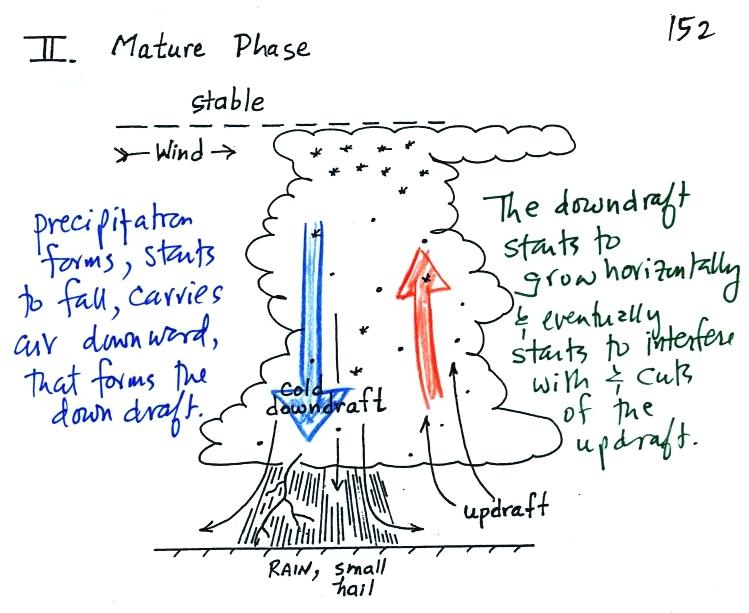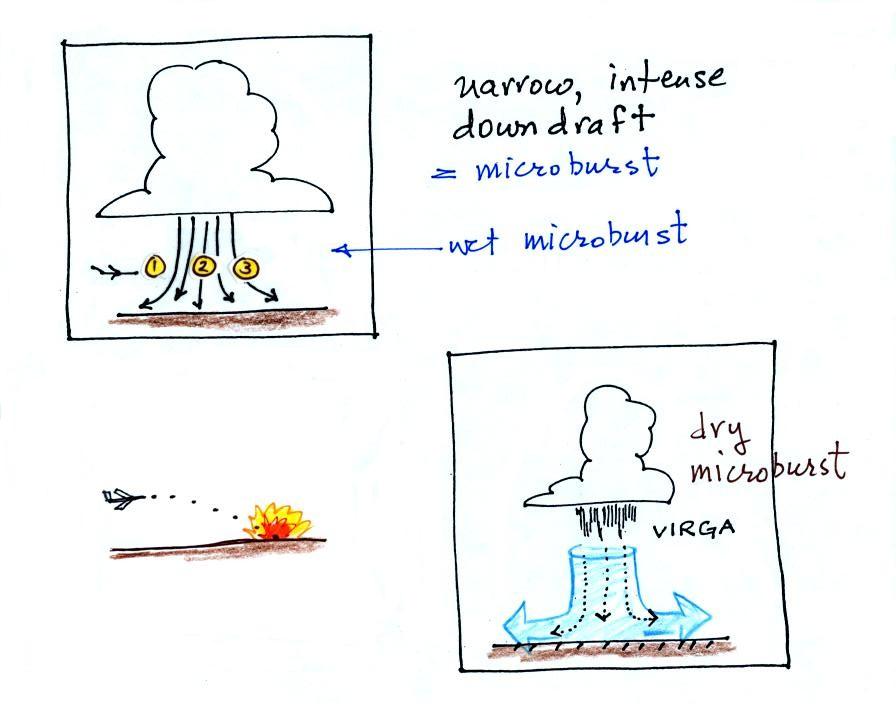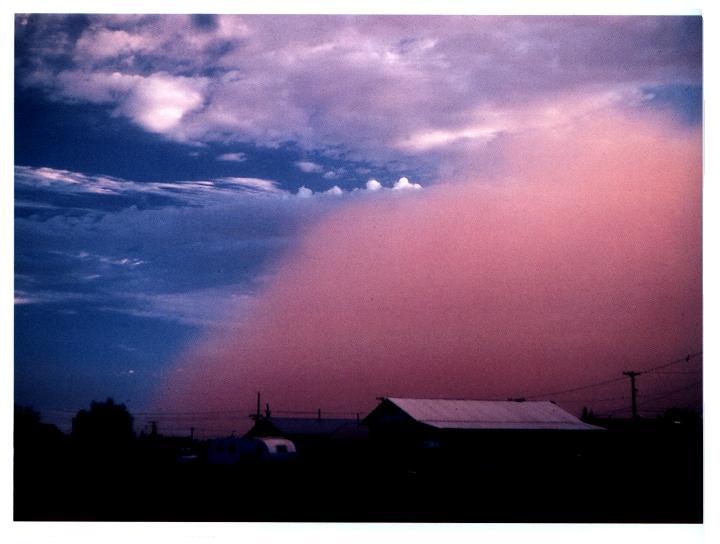Mon., April 21, 2014
Time enough for "One and Only"
and "Set
Fire to the Rain" from
Adele before class today. Man can she ever sing. Might
just have to play songs of hers for the rest of the semester.
The Rainbows, Mirages, and Green Flash reports have been graded
and were returned today. They'll be included in the grade
summaries that I'm planning on handing out on Wednesday. I
still have the Regional Winds and Foucault Pendulum reports.
They haven't been graded yet.
The Atmospheric Stability worksheets were collected today.
I can see the light at the end of the semester and have a
pretty good idea what we will be covering between now and
then. Here are the topics that will lead up to Quiz #4.
Today: Thunderstorms pt. 1
Wednesday (Apr. 23): Thunderstorms pt. 2 & Tornadoes pt. 1
Friday: Tornadoes pt. 2 & Lightning pt. 1 (perhaps)
Monday: Lightning
Wednesday (Apr. 30): Quiz #4
Today and part of next Wednesday will be devoted to
thunderstorms. Here's a little bit of an introduction
(found on p. 150 in the ClassNotes)
Thunderstorms come in different sizes and levels of
severity. We will mostly be concerned with ordinary
single-cell thunderstorms (also referred to as air mass
thunderstorms). They form in the middle of warm moist air,
away from fronts. Most summer thunderstorms in Tucson are
this type. An air mass thunderstorm has a vertical
updraft. A cell is just a term that means a single
thunderstorm "unit" (a storm with an updraft and a downdraft).
Tilted updrafts are found in severe and supercell
thunderstorms. As we shall see this allows those storms to
get bigger, stronger, and last longer. The
tilted updraft will sometimes begin to rotate. We'll see
this produces an interesting cloud feature called a wall cloud
and maybe tornadoes. Supercell thunderstorms
have a complex internal structure; we'll watch a short
video at some point that shows a computer simulation of the
complex air motions inside a supercell thunderstorm.
We won't spend anytime discussing mesoscale convective
systems except to say that they are a much larger storm
system. They can cover a large portion of a state.
They move slowly and often thunderstorm activity can persist for
much of a day. Occasionally in the summer in Tucson we'll
have activity that lasts throughout the night. This is
often caused by an MCS.
The following somewhat tedious material was intended to
prepare you to better appreciate a time lapse video movie of a
thunderstorm developing over the Catalina mountains. I
don't expect you to remember all of the details given
below. The figures below are more carefully drawn versions
of what was done in class.

Refer back and forth between the lettered points in the
figure above and the commentary below.
The numbers in Column
A show the temperature of the air in the atmosphere at
various altitudes above the ground (note the altitude scale on
the right edge of the figure). On this particular day the
air temperature was decreasing at a rate of 8 C per
kilometer. This rate of decrease is referred to as the
environmental lapse rate (lapse rate just means rate of decrease
with altitude). Temperature could decrease more quickly
than shown here or less rapidly. Temperature in the
atmosphere can even increase with increasing altitude (a
temperature inversion).
At Point B,
some of the surface air is put into an imaginary container, a
parcel. Then a meteorological process of some kind lifts
the air to 1 km altitude (in Arizona in the summer, sunlight
heats the ground and air in contact with the ground, the warm
air becomes buoyant - that's called free convection). The
rising air will expand and cool as it is rising.
Unsaturated air (RH is less than 100%)
cools at a rate of 10 C per kilometer. So the 15 C
surface air will have a temperature of 5 C once it arrives at 1
km altitude.
Early in the morning "Mother Nature" is only able to lift the
parcel to 1 km and "then lets go." At Point C note that
the air inside the parcel is slightly colder than the air
outside (5 C inside versus 7 C outside). The air inside
the parcel will be denser than the air outside and the parcel
will sink back to the ground. You can't see this because
the air is clear, transparent.
By 10:30 am the parcel is being lifted to 2 km as shown at Point D. It
is still cooling 10 C for every kilometer of altitude
gain. At 2 km, at Point E the
air has cooled to its dew point temperature, the relative
humidity is now 100%, and a cloud has formed. Notice
at Point F,
the air in the parcel or in the cloud (-5 C) is still colder and
denser than the surrounding air (-1 C), so the air will sink
back to the ground and the cloud will disappear. Still no
thunderstorm at this point.
At noon, the air is lifted to 3 km. Because the air
became saturated at 2 km, it will cool at a different rate
between 2 and 3 kms altitude. It cools at a rate of 6 C/km
instead of 10 C/km. The saturated air cools more slowly
because release of latent heat during condensation offsets some
of the cooling due to expansion. The air that arrives at
3km, Point H,
is again still colder than the surrounding air and will sink
back down to the surface.
By 1:30 pm the air is getting high enough that it has become
neutrally buoyant, it has the same temperature and density as
the air around it (-17 C inside and -17 C outside). This
is called the level of free convection, Point J in the figure.
If you can, somehow or another, lift air above the
level of free convection it will find itself warmer and less
dense than the surrounding air as shown at Point K and will
float upward to the top of the troposphere on its own.
This is really the
beginning of a thunderstorm. The thunderstorm
will grow upward until it reaches very stable air at the bottom
of the stratosphere.
This was
followed by a time
lapse video showing a day's worth of work leading
eventually to the development of a thunderstorm. The
computer in our classroom wouldn't display the video (it did
work in the ILC building later in the day). Click on the
link and see if your computer will play the movie.
The events leading up to the initiation of a summer air mass
thunderstorm are summarized in the figure below. It can take
a good deal of effort and often a
good part of the day before a thunderstorm forms. The air
must be lifted to just above the level of free convection (the
dotted line at middle left in the picture). Once air is
lifted above the level of free convection it finds itself warmer
and less dense that the air around it and floats upward on its
own. I've tried to show this with
colors below. Cool colors below the level of free
convection because the air in the lifted parcel is colder and
denser than its surroundings. Warm colors above the
dotted line indicate parcel air that is warmer and less dense
than the surroundings. Once the parcel is lifted above
the level of free convection it becomes buoyant; this is
the moment at which the air mass thunderstorm begins.
Once a thunderstorm develops it
then goes through a 3-stage life cycle

In
the first stage you would only find updrafts inside the cloud
(that's all you need to know about this stage, you don't even
need to remember the name of the stage).

Once precipitation has formed and grown to a certain size, it
will begin to fall and drag air downward with it. This
is the beginning of the mature stage where you find both an
updraft and a downdraft inside the cloud. The falling
precipitation will also pull in dry air from outside the
thunderstorm (this is called entrainment). Precipitation
will mix with this drier air and evaporate. The
evaporation will strengthen the downdraft (the evaporation
cools the air and makes it more dense).
The thunderstorm is strongest in the mature stage. This
is when the heaviest rain, hail, strongest winds, and most of
the lightning occur.
Eventually the downdraft spreads
horizontally throughout the inside of the cloud and begins to
interfere with the updraft. This marks the beginning of
the end for this thunderstorm.

The downdraft
eventually fills the interior of the cloud. In this
dissipating stage you would only find weak downdrafts
throughout the cloud.
Note how the winds from one
thunderstorm can cause a region of convergence on one side of
the original storm and can lead to the development of new
storms. Preexisting winds refers to winds that were
blowing before the thunderstorm formed. Convergence
between the preexisting and the thunderstorm downdraft winds
creates rising air that can initiate a new thunderstorm.
Here's a sketch of 4 thunderstorm clouds and a question: what
information could you add to each picture.
You'll find the answer to the question at the end of today's
notes.
The picture below shows some of the features at the base of a
thunderstorm.
The cold downdraft air spilling out of a
thunderstorm hits the ground and begins to move outward from underneath the thunderstorm. The
leading edge of this outward moving air is called a gust
front. You can think of it as a dust front because the
gust front winds often stir up a lot of dust here in the desert
southwest (see below).
The gust front in this picture
(taken near Winslow,
Az) is moving from the right to the left.
Visibility in the dust cloud can drop to near zero which
makes this a serious
hazard to automobile traffic. Dust storms like this
are sometimes called "haboobs".
There's lots of video on YouTube of an impressive dust storm a
few summers ago. Here's an example
from Gilbert Arizona. Another
from South Mountain (same storm seen from a different
location). You can see day literally turn to night when the
dust cloud is overhead.
Here's a
video from a summer 2012 dust storm captured from the front
window of a vehicle that drove through the storm. This video wasn't shown in class.
Check the last minute or two of the video where visibility drops
to near zero. Officials recommend that you drive off the
highway under conditions like this, turn off your lights, and take
your foot off the brake so that your brake lights are not
on. Otherwise someone might follow your lights thinking
you're still on the highway and run into you from behind.
And finally an
interesting report on the 1935 Black Sunday dust storm in
the Central Plains. I'm not sure but it doesn't sound like
this was caused by thunderstorm winds, rather winds from a larger
storm system.

A narrow intense
downdraft is called a microburst. At the ground microburst
winds will sometimes reach 100 MPH (over a limited area); most
tornadoes have winds of 100 MPH or less. Microburst winds
can damage homes (especially mobile homes that aren't tied to
the ground), uproot trees, and seem to blow over a line of
electric power poles at some point every summer in Tucson (sometimes leaving motorists
trapped in their cars under live electric lines.
Microbursts
are a serious threat to aircraft especially when they are close
to the ground during landing or takeoff. An inattentive
pilot encountering headwinds at Point 1 might cut back on the
power. Very quickly the plane would lose the headwinds
(Point 2) and then encounter tailwinds (Point 3). The
plane might lose altitude so quickly that it would crash into
the ground before corrective action could be taken.
Microburst associated wind shear was largely responsible for the
crash of Delta
Airlines Flight 191 while landing at the Dallas Fort Worth
airport on Aug. 2, 1985.
Falling rain could warn of a wet
microburst (see photo below). In other cases, dangerous dry microburst
winds might be invisible (the virga,
evaporating rain, will cool the air, make the air more dense,
and strengthen the downdraft winds).
Here are a couple of microburst
videos from YouTube. The first video
was taken in the heavy rain and strong winds under a
thunderstorm in the microburst. You'll see a power pole
snapped in half by the microburst winds at about 2:26 into the
video. The 2nd video
was taken in or near San Tan AZ. The microburst doesn't look
too impressive at the start of the footage but the storm winds
soon get pretty violent and cause some damage.
The
following material wasn't covered in class on Monday.
I'll come back to it briefly at the start of class on Wednesday.
A sketch and a photograph of a
shelf cloud. Warm
moist air if lifted by the cold air behind the gust
front which is moving from left to right.
The shelf cloud is very close to the ground, so the
warm air must have been very moist because it didn't
have to rise very far before it had cooled enough to
become saturated and form a cloud. Here
are a couple of pretty good videos of shelf clouds (Grand
Haven, MI and Massillon,
OH)
And here's a
video that shows both a thick dust cloud at the
leading edge of an approaching gust front and a shelf cloud.
Here's the answer to a question embedded in today's notes.

The first 3 pictures shows the different
stages in the lifetime of an air mass thunderstorm.
There's a tilted updraft in the 4th picture which is a
characteristic of a severe thunderstorm.














